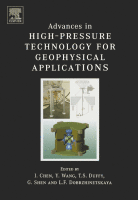Browse content
Table of contents
Actions for selected chapters
- Full text access
- Book chapterNo access
Author index
Pages 511-512 - Book chapterNo access
Subject index
Pages 513-515
About the book
Description
High-pressure mineral physics is a field that is strongly driven by the development of new technology. Fifty years ago, when experimentally achievable pressures were limited to just 25 GPa, little was know about the mineralogy of the Earth's lower mantle. Silicate perovskite, the likely dominant mineral of the deep Earth, was identified only when the high-pressure techniques broke the pressure barrier of 25 GPa in 1970s. However, as the maximum achievable pressure reached beyond one Megabar (100 GPa) and even to the pressure of Earth’s core on minute samples, new discoveries increasingly were fostered by the development of new analytical techniques and improvements in sensitivity and precision of existing techniques.
The book consists of six sections which group the papers according to their main topics: a) Elastic and Anelastic Properties; b) Rheology; c) Melt and Glass Properties; d) Structural and Magnetic Properties; e) Diffraction and Spectroscopy; f) Pressure Calibration and Generation. As many papers cover multiple topics, readers may find papers of interest in different sections. All papers are prepared with emphasis on technical details suitable for a technical reference. Many on-line software resources are also listed in as detailed a manner as possible. However, the URL of the software sites may be subject to change without notice.
High-pressure mineral physics is a field that is strongly driven by the development of new technology. Fifty years ago, when experimentally achievable pressures were limited to just 25 GPa, little was know about the mineralogy of the Earth's lower mantle. Silicate perovskite, the likely dominant mineral of the deep Earth, was identified only when the high-pressure techniques broke the pressure barrier of 25 GPa in 1970s. However, as the maximum achievable pressure reached beyond one Megabar (100 GPa) and even to the pressure of Earth’s core on minute samples, new discoveries increasingly were fostered by the development of new analytical techniques and improvements in sensitivity and precision of existing techniques.
The book consists of six sections which group the papers according to their main topics: a) Elastic and Anelastic Properties; b) Rheology; c) Melt and Glass Properties; d) Structural and Magnetic Properties; e) Diffraction and Spectroscopy; f) Pressure Calibration and Generation. As many papers cover multiple topics, readers may find papers of interest in different sections. All papers are prepared with emphasis on technical details suitable for a technical reference. Many on-line software resources are also listed in as detailed a manner as possible. However, the URL of the software sites may be subject to change without notice.
Key Features
* State of the art in a very important branch of geophysics, namely the experimental determination of material behavior at the extreme conditions of planetary interiors
* Emphasis on technical details suitable for a technical reference
* Includes many on-line software resources
* State of the art in a very important branch of geophysics, namely the experimental determination of material behavior at the extreme conditions of planetary interiors
* Emphasis on technical details suitable for a technical reference
* Includes many on-line software resources
Details
ISBN
978-0-444-51979-5
Language
English
Published
2005
Copyright
Copyright © 2005 Elsevier B.V. All rights reserved
Imprint
Elsevier Science
